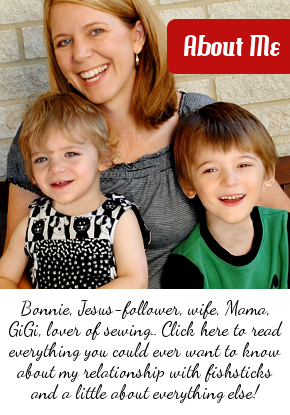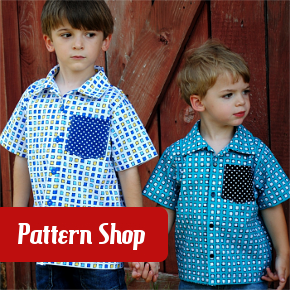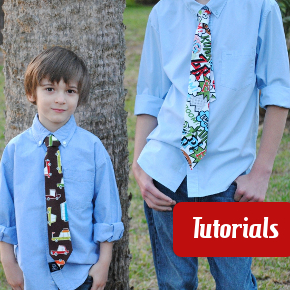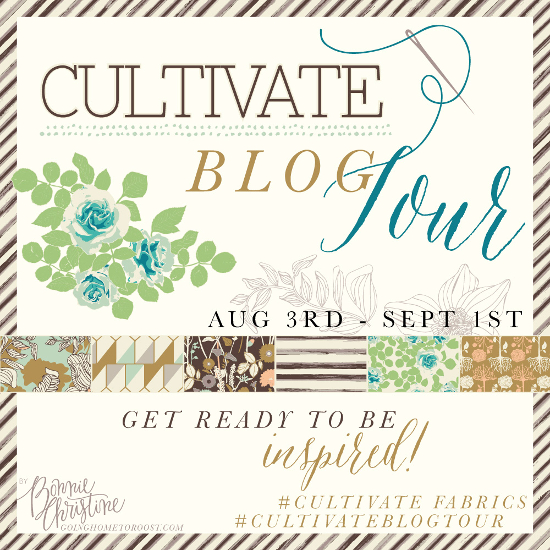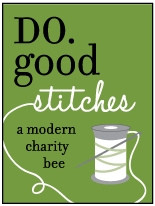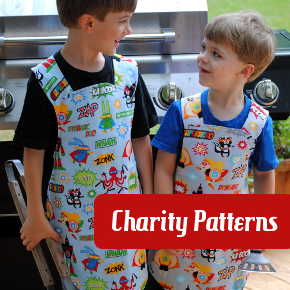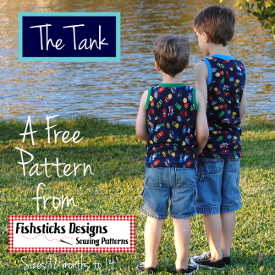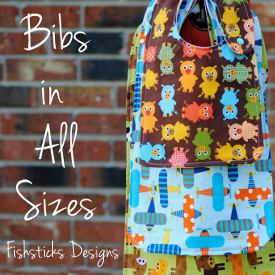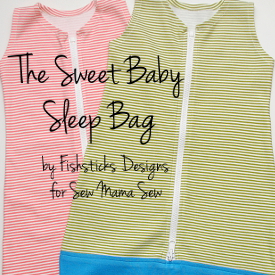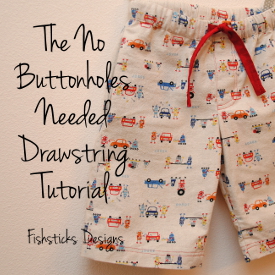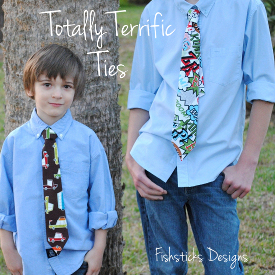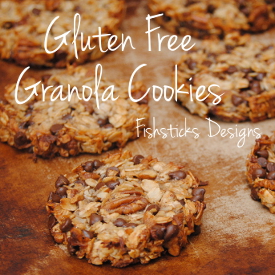Knit Knowledge Week
Knit Knowledge–Questions & Answers
Such great questions! I can’t answer all of them today (I do have to sleep a little!), but I have a list printed out, and I’ll do my best to provide more answers in later posts.

There were quite a few questions about the other stitches that are recommended for sewing knits. The three primary ones are in this picture above. The first is the “stretch stitch”. It sort of looks like a lightning bolt. The stretch stitch is designed for use with stretchy fabrics and is a great choice to cut down on broken stitches. I don’t use it, simply because I don’t care for the look of it. The second set of stitches is a regular zig-zag, and the third is the three-step zig zag. Those are also good choices because the zig-zag gives a bit more room for the fabric to stretch.
There is also the option of using a twin needle for hemming your knits. That is another great choice because you get two lines of straight stitching on the front of your fabric and a zig zag on the back. I don’t use it because :bag over head: I’ve never been able to get it to work well on my machine. Mastering the twin needle is on my to-do list!
Valarie, Jill and Michelle S. asked, “Do you use a straight stitch for your topstitching?” Laura B. asked, “Do you find that a straight stitch pops over time?”
I use a regular straight stitch for topstitching with stretchy nylon serger thread in the bobbin. So far, I’ve not had any problem with those stitches popping. When I was just using a straight stitch for my hems, I did notice those stitches popping over time.

Laura B. wrote, “Recently I sewed a maternity top for myself out of a lightweight jersey knit. It came out beautifully, except for the shirt hem and sleeve hems, which always flip up. Is there any way I can remedy this? I just serged the edge, turned it up 1/2″, and topstitched it, as per the pattern.”
There are a couple of things that you can try out, Laura. It sounds to me like the hemming allowance on that particular top isn’t enough for the lightweight jersey that you’re using. I would suggest if using this pattern again with the same type of fabric that you increase the hemming allowance to 1″. I think that will make a big difference. My second suggestion is to not hem it at all and just let the jersey roll up on the hems instead. I actually have a few ready-to-wear tops in my closet that are finished that way!

Barbara asks, “Do you find it neccesary to use your sewing machine to sew over a serged edge to reinforce the threads?”
When I’m sewing knits, no, I don’t go back and sew over the serged edge. When I’m sewing wovens, I do, but with knits, I’ve always found that the serged edge holds up great!
Jill and Kimberly both asked, “How do you go about putting stretchy nylon serger thread in the bobbin for your sewing machine?” and Kimberly also wanted to know, “Does it change your thread tension?”
This really depends on your machine. I use my machine to wind the nylon serger thread onto the bobbin, but I do have to be really careful to make sure that it doesn’t go on too tight. I’ve actually had a few bobbins break when I wasn’t paying close attention. Many sewists wind the wooly thread onto the bobbin by hand. As far as the tension, it does not change on my machine, but that’s, again, something you’ll have to test out on your own machine to be sure.
Valarie wrote, “What seams can/should be sewn with a coverstitch machine, if a person has one?”
For those who don’t know, a coverstitch machine is what hems on most ready-to-wear clothing are finished with. It sews two rows of straight stitches on the right side of the fabric and an overlocking stitch on the wrong side.

I used to dream about owning a coverstitch machine, but recently I’ve decided to forego purchasing one. Most home seamstresses don’t have access to one, and I want to be able to provide instruction and inspiration to as many sewists as possible. All that said, because I’ve never used a coverstitch, I’m actually not sure if you can use it for seams other than the hem.
Ananda asked, “Do you switch the needles on your serger to ball point needles as well?”
Yes. I do use ball point needles in my serger when working with knits, as well.
Erin’s question is, “When buying knits how do you know what is an interlock knit? I noticed you said they have a “v” on the front and back but I don’t really know what that means. Is there a special word when shopping at a store to look for? I don’t think I have ever seen a separate interlock knit section.”
I snapped a few pictures of a pair of longies that I’ve been knitting because I think the pictures will help. Knit fabrics are knitted similarly to the way we knit when we knit by hand. Here’s a picture of the what the front of a traditional stockinette stitch looks like. See how it has a repeating “v” pattern?
Interlocks have this same “v” pattern on both the front and the back of the fabric. Here’s what the “-” purl pattern looks like on the back of my knitting.

On jerseys, you’ll see the “v” pattern above on the front and the “-” pattern on the back. Now let’s look at the waistband of my longies. When knitting, this ribbing is produced by knitting two stitches and purling two stitches.

If you look closely at the top of the picture, you’ll see that the pattern is the same on both the front and the back. Ribbed knits look just like this.
When you go into your local fabric store, you can definitely ask if they have a section of cotton interlocks. Joanns carries solid interlocks in a cotton/polyester blend and children’s print interlocks in 100% cotton. Hancocks carries a selection of solid interlocks in 100% cotton.
Jada wrote, “I have been having trouble with thinner knits (I think jersey, but some are interlock) getting chewed up in my sewing machine. I’m using the correct needle and everything, but the fabric just gets pushed down and chewed up. Do you have any suggestions?”
I hate when that happens! First, try a few maintenance things: Change out your sewing machine needle and brush off the feeddogs to make sure that neither of those is an issue. If that doesn’t help, toss that thin knit in the trashcan, yell a few times, turn off the machine, walk around the house and cool off a little. Whew! Feel better? Okay, now pull the fabric back out of the trashcan, and try these things. When you start a row of stitches, start in about an inch and backstitch first but don’t go quite all the way to the edge, then forward stitch. When you hem, be sure to fold over and fold over again so you have a little more thickness to work with. Hopefully, those things will help.
Bekah asks, “#1- What was the first thing you ever made with knit fabric? (mine was a fitted diaper) #2- What is your current favorite knit (print) on the market?”
I don’t think it was actually the very first thing that I sewed with a knit fabric, but sewing fitted diapers for my now four-year-old is definitely what kick-started my love for sewing knit clothing! These were some of the very first diapers that I sewed about five years ago:

As far as my favorite knit print that’s on the market right now . . . I’m not sure that I have an absolute favorite. I mostly sew for my boys right now, so I love the Dino Dudes by Michael Miller. The puppy print that I used for the applique tutorial yesterday is a definitely a favorite, although I wish it didn’t have a white background. The old Joann’s farm print is one of my all-time favorites. I actually just used the last of what I had of it in a coverall for Charlie. Jeanne at Nature’s Fabrics has some Znok Fabrics that are due in this week, and they make my heart skip a beat. They’re a little expensive, though. I keep putting a few yards in my basket and then closing the window before I check out. This Zoo Animals print and this Train Adventure print from The Fabric Fairy are both so cute in person! Okay, I must stop window shopping, or I’ll never finish this post!
Valarie wants to know, “Is it ok to sew garments with rib knits containing 5% spandex or should it just be used for neck lines and cuffs?”
You can definitely sew with ribbed knits that contain spandex. Ready-to-wear ribbed tanks are often made with a little spandex mixed in the fiber.
Ananda asks, “What do you do with ribbing that comes in a tube? Cut one side so it’s flat?”
That is exactly what I do with it.
Colleen wants to know, “Can you tell us how many layers you use to make your cloth tissues? Thanks!”
Sure! I use two layers of cotton velour in our tissues so they end up double-sided. I cut them about 8 1/2″ X 6 1/2″ then serge.

Alisa writes, “How do you know if the knit you order online (as I am assuming you do) is going to be a good quality fabric? I once ordered some knit fabrics online and I was so dissappointed with the quality. I have also used Michael Miller’s knits which were great to work with. Are there certain names or manufacturers that have a reputation for quality knit fabrics?”
I do order most of my knit fabrics online, and sometimes I just end up with fabrics that aren’t what I’d expected. The Little Miss Sunshine fabric that you see in this post is a case in point. I’m pretty sure that it’s the thinnest rib knit I’ve ever seen. I love shopping at The Fabric Fairy because they list the weight of each fabric which really helps when you can’t actually touch the fabric. My favorite weight knits are between 9.5 and 11 ounces per yard. Most online shops, if you are unsure about a fabric, will let you order a swatch (often for FREE!) to check it out before ordering.
Trisha asks, “My question is how to get the hems lined up nicely when you hem them before you sew the side seams together? No matter how much I measure and try to get my hems the same size, the stitching just does NOT match up at the seams.”
You mean your side seams look like this?

Honestly, my seams never line up exactly, and I’ve never worried much with it. I just make sure that the bottom of the hem, the underarm seams and the bottom of the sleeve hem line up. I don’t think that a little bit of difference in the how the hem seams line up is noticeable when the clothing is worn.
Finally, Yara asks, “What is the best place to buy knits?”
Well, I’ve mentioned the The Fabric Fairy more than a few times, and they are giving away a $20 gift certificate to one of my readers, so you should definitely start there! They are a great store to work with and have amazing customer service.
There are a few other online shops were I enjoy shopping, as well:
Sewzannes Fabrics
A&A’s Fabric Attic
Wise Sewing Supplies
The Fabric Zoo
Nature’s Fabrics
Girl Charlee
Fabric.com
I’m sure I’m missing a few. If you have a favorite that I haven’t listed, please add it to the comments section!
Alright, I think that’s all I can manage for now. I have a list of later blog post topics including rolled and lettuce edging, serging tips, reinforcing seams (I’ve never done this, but I want to research it a bit) and working with swimsuit fabrics.
Finally, there’s a giveaway to do! Thank you all so much for all your questions and comments. I’m hoping that this series will prove valuable for many more sewists in the months and years to come! There were 143 comments and questions between the four posts. I let random.org choose a number:

Then I counted starting from post one, and found the winner in post number two, and that winner is . . . Katie! Congratulations, Katie! I can’t wait to see what fabrics you buy and what you sew with it for your family. You have to be sure to share pictures!
Knit Knowledge–Simple Appliques & Hemming Tips

Now that you know all about the different types of knits. Let’s learn a little about adding the finishing details and a little extra punch to your knit sewing projects.
Because knits don’t fray like wovens, appliqueing with them is really easy! Here are the few things that you need to get started: a fabric that you’d like to applique, a fabric cut to applique on and a lightweight iron-on adhesive product like HeatnBond Lite (you want one that says it’s “sewable”).

Begin by using a washable marker to outline the sections that you’d like to cut out of your applique fabric.

Trim down your applique fabric so you have just a little extra left outside of the actual applique outlines, and cut out a piece of iron-on adhesive the same size as the applique fabric you have left.

Iron the applique fabric to the iron-on adhesive.

Cut out your appliques. (I cut just inside the washable marker.)

Peal the backing off of the iron-on adhesive.

Decide on the position of your appliques keeping the seam allowances in mind. (This is the side panel from the vertical colorblocked Charlie Tee, so it has a 1/2″ seam allowance.) You’ll see here that I decided after laying them out that I needed an additional smaller applique at the top to balance things out.

Iron the applique on to the main fabric. (If you’ll be overlapping them a bit like mine, start with the one on the bottom of the overlapping.)

Now just stitch around the applique. I generally keep my stitching about 1/8″ to 1/4″ from the edge. I intentionally did these a little messy, and I love the look!

Add a few more, if you’d like. Now wasn’t that easy?

I’m covering hemming last, but when I sew knits, I always hem first. I’ve found that hemming when you have a flat piece of fabric cuts down tremendously on the amount of puckering that you’ll have in your finished project. I covered hemming on my blog a while back. You’ll find my original post here: Hemming Knits Part 1. All of those tips are still great and work really well. I have, however, personally changed my hemming method a little. The way I was hemming then worked great for my guys until they got a bit bigger and started stretching and pulling on their clothes. Then, even with the stretchy nylon thread in the bobbin, our hems were breaking.
I was sharing my frustration over this with my friend, Michelle, one day, and she asked me if I used the triple-stretch stitch on my machine. Hmmmm. . . I’d never even heard of that! See–I told you I’m still learning new things along the way. Now, though, thanks to Michelle, I have a method of hemming that never fails! It takes a few extra minutes, but I think it’s worth the extra effort to have a finished product that not only will last for one season, but that I can pass down from child to child.
Here’s what that triple stretch stitch looks like on my machine. It’s stitch #5. (Am I the only one who didn’t know about it before?)

I start out my hemming by either folding up part way and folding up again or by serging off the edge and then folding up the hem allowance. (If you’re just starting with knits, use the first method because stitching through that extra layer will help cut down on the stretching while you’re sewing.) 
If your knit fabric is really stretchy or if it’s rolling on you, use a little spray starch before you press.

Now, when I sew with knits, I always (ALWAYS!) have a stretchy nylon serger thread in my bobbin. (I’ve used Wooly Nylon in the past. Now I’m using Maxilock Stretch.) When I start my hem, I like to sew on the inside. If you only have white stretchy nylon serger thread, then you’ll have to sew on the right side if your fabric isn’t white, though. In this case, I’m sewing on the inside for the first step: straight across the top of the hem using a regular straight stitch.

I left the orange thread from the applique above as the top thread so you could see that I sewed this step on the inside.

Then I flip my fabric piece over and switch to the triple stretch stitch, and sew again on the front side of the fabric right on top of the original stitching.

(Now you’re wondering why I don’t just use the triple stretch stitch and skip the first step. I tried that, but the triple stitch pulls the fabric back and forth under the presser foot to make three stitches side by side, and I found that if I didn’t sew down the whole length first, I always ended up with wonkiness. I’m assuming that’s because of the back and forth motion of the triple stretch stitch.)

All done! A hem that won’t disappoint you!

HEMMING UPDATE:
When I wrote the above information about hemming knits, I was looking for a great way to hem that wouldn’t come undone. The preferred way to hem knits is with a twin needle. It gives a nice side-by-side double stitch on the front with a zig-zag on the back which allows the fabric to stretch without the stitches popping. At the time, I’d been unable to master using a twin needle which, frankly, given that I have a business built on sewing with knits, was a bit embarrassing.
Not too long after this Knit Knowledge Series wrapped up, I got determined to figure out this twin needle thing once and for all. I sat down at the machine, pulled out my twin needle and grabbed the manual for my machine. I skimmed over the instructions as I’ve done in the past, but something new caught my eye.
Do I admit that it was there all along, or do I try and convince you that someone must have added this little detail to my owner’s manual secretly at some point? What is this little bit of important information? Well, the instructions for twin needle sewing begin, “Press the twin needle key to enter the twin needle sewing mode.” Wait! What?! There’s a twin needle key? Oh, look, there it is. (In fact, if you scroll up to where I posted the picture of the touch pad on my sewing machine, you can see it on the bottom center of the screen.)
And guess what happened? I pressed that little key, installed the twin needle, threaded everything up, and I’ve stitched all my hems beautifully with a twin needle since. I suppose that’s a good lesson in reading the instructions . . . and if it still doesn’t work after you’ve read the instructions, maybe you should read them again.

Knit Knowledge–Ribbed Knits, Ribbing & Pile Knits

Ribbed knits are the stretchiest of the three main types of knits. Ribbed knits are characterized by the vertical ribs that you’ll see when you give the fabric a little stretch.

100% cotton ribbed knits tend to be very soft and are great for the bodies of tees, pajamas, baby clothing and lots more. They aren’t great for necklines or trim that needs good recovery, though, because they tend to stretch out and not bounce back.



I find cotton ribbed knits the most difficult to work with because they stretch so much. You have to take the greatest amount of care with them to not stretch while you’re sewing. With ribbed knits, a walking foot is really a must! It’ll help prevent seams that look like this (more about hemming tomorrow):


Ribbing is actually a type of ribbed knit. It sometimes comes in a tube rather than flat on a bolt. Ribbing usually has a small amount (3%-5%) of lycra or spandex mixed with the cotton fibers. Because of the lycra or spandex, ribbing is perfect for neckbands, trim and waistbands. (The Comfy Sleep Set in Stitch magazine uses cotton/spandex ribbing for the waistband.)


In addition to the three main types of flat knits that we’ve already discussed, there are knits that have a pile or texture to them. French terry is smooth on the front side and has loops on the back. French terry works well for lightweight loungepants and sweatshirts. Sweatshirt fleece is similar to french terry only the loops on the back side are cut and brushed for a softer feel. Sweatshirt fleece is usually a bit heavier than french terry as well. Both french terry and sweatshirt fleece have very little stretch. Sewing either of them is similar to sewing woven fabrics.



Stretch terry is the fabric that you’ll most often find in hooded baby towels. It’s the opposite of french terry with the loops on the front and a smooth back. Stretch terry is usually cotton on the front with a backing of polyester and has a good amount of stretch. Velour is basically stretch terry with the loops sheared off and brushed smooth. Cotton velour is luxuriously soft and squishy. It, too, usually has polyester in the backing and stretches well. It’s a perfect choice for baby clothing and loungewear, and our favorite use for it this time of the year is in cloth tissues. They are so, so soft on sore runny noses.



Oh, the questions! They are awesome. Many of them I can answer. Some of them, though, have sent me off researching. I love it! Keep ’em coming! For an entry into this week’s drawing, add a comment to this post with either a question that you’d like me to answer on Friday–I won’t get to answer them all, but I will answer as many as I can–or comment with an answer to this question from me: Today’s question is, “What is your favorite knit print that is available to purchase today?” If you don’t yet have a favorite, go do a little window shopping and see what you can find. You can start at The Fabric Fairy and dream a little about what you’d spend the $20 gift certificate that Caroline has donated if you win!
Knit Knowledge–Interlock Knits and Jerseys
INTERLOCKS

I’m starting out with interlocks, specifically cotton or cotton/polyester blend interlocks, because I always recommend that beginners start with interlock. Honestly, given a choice, I will almost always choose cotton interlock when sewing knit clothing for my family. It has such great qualities. Interlock has a nice weight to it–not too heavy, not too light–which makes it easy to sew and comfortable to wear. It has a good amount of stretch and good recovery. (Recovery is a knit fabric’s ability to bounce back to the size it started. Some knits stretch out and stay stretched until they’re washed and dried.)
Interlocks have the traditional “v” knit shape in the weave on both the front and the back of the fabric. In solid colors, it’s really impossible to tell a difference between the sides of the fabric.



I use cotton and cotton/polyester interlock for the main body sections of tops and pants and for neckbands, armbands and legbands. If you use it for a waistband, though, you will need to hide elastic inside. (Cotton/lycra or cotton/spandex blends are better for elastic-free waistbands. We’ll get to those later.)
JERSEYS

Jerseys are lighterweight than interlocks. If you grab a t-shirt from your closet, you’ll most likely find that it was sewn with cotton jersey. Jerseys are easy to recognize. They have that “v” knit pattern in the weave on the front and the “-” purl pattern in the weave on the wrong side of the fabric. Jerseys also roll on the cut edges.

It’s the rolling that often makes jerseys difficult to work with. I have a couple of suggestions for dealing with the rolling. Experience has shown me that the best way to deal with it is to cut and sew right away. The longer you leave a jersey to sit after you’ve cut out your pattern, the more rolling you’re going to have to deal with. When you first cut, the fabric will lie fairly flat. Another thing you might try is spraying the edges with a little spray starch, then ironing to help them hold their shape while you sew.


100% cotton jerseys have a minimal amount of stretch and are great for the bodies of tees. They work well in pajama pants and baby clothing, too. You’ll also find jerseys made from a list of other natural and synthetic fabrics along with blends of natural and synthetic fibers. I prefer cotton/lycra and cotton/spandex jerseys in the tops that I sew for myself because of the nice drape and the extra stretch that the spandex or lycra adds. Those same cotton/lycra and cotton/spandex jerseys also work well in yoga-style waistbands on skirts or loungepants because of their superb recovery.

Keep the questions coming! Remember that you’ll get an entry into Friday’s drawing for a $20 gift certificate from The Fabric Fairy for every question or comment you post this week (one comment or question per person per blog post, please). Today’s question for you, in case you don’t have a question for me, is “If you’re already comfortable with sewing knits, what type of clothing do you sew most often? If you’re not, what items of clothing do you think you’d choose to sew if you were?”
Knit Knowledge – Introduction & Overview

Welcome to Knit Knowledge Week! I’m asked questions about working with knit fabrics really often, so I thought I’d spend a week sharing some of my knowledge with you. I’m quite certain that I don’t know everything there is to know about working with knits, and I still occasionally discover a new technique that works better than what I was doing before. Everything I’ll share is what I’ve learned through my own hands-on experience.
My plan is to spend the week sharing a bit each day. Here’s the lineup that I have planned: Monday: Knit Overview, Tuesday: Interlock Knits & Jerseys, Wednesday: Ribbed Knits & Ribbing, Thursday: Hemming & Simple Applique, Friday: Questions & Answers and the Giveaway.
This week will require some participation from you, too. In order for me to have a Q&A on Friday, I need you to post any questions that you have in the comments section Monday through Thursday. Then, I’ll choose as many questions as I can and answer them on Friday (if I haven’t already answered them during the week).
Friday’s post will also include an exciting giveaway! Caroline at The Fabric Fairy has generously donated a $20 gift certificate that you can use in her store to purchase some knit fabrics from her incredible selection to try out for yourself. Just comment on my posts Monday through Thursday (one comment per post, please), and I’ll hold a random drawing on Friday morning.
Alrighty, let’s get started with a quick overview.
OVERVIEW
First off, don’t be afraid of knits! Knit fabrics, primarily cotton and cotton-blend knit fabrics, are what most of us live in! Once you become comfortable sewing them, you’ll be ready to sew up whole wardrobes of comfortable clothing that you and your loved ones will love to wear.
THE BASICS
ThinkQuest explains, “Knitted fabrics are made from a single yarn or a set of yarns. In making cloth, a knitting machine forms loops in the yarn and links them to one another by means of needles. The finished fabric consists of crosswise rows of loops, called courses, and lengthwise rows of loops, called wales. This looped structure makes knitted fabrics more elastic than woven cloth. Garment manufacturers use knitted fabrics in producing comfortable, lightweight clothing that resists wrinkling.”
Simply put, knit fabrics have stretch. Some, like sweatshirt fleece, have only a little stretch. Others, like cotton ribbed knits, have a whole lot of stretch.
The stretch in most knit fabrics runs across from selvage to selvage. When you place your pattern pieces on knit fabrics that show grainlines rather than direction of stretch, you generally want the grainline to run perpendicular to the stretch.
The right tools:

Before working with knit fabrics, you’ll want to switch out the regular foot on your machine for the walking foot. Your sewing machine has “teeth” that guide the bottom of the fabric under the foot while the needle sews. A walking foot has similar teeth that grip the top of fabric so top and bottom pass through under the needle evenly. This feature helps a great deal in cutting down on the amount of puckering that you’ll see in your knit fabric seams.

It’s also a good idea to switch out your sharp sewing machine needle for a ballpoint needle. Sharp needles cut through the knit loops on your fabrics and leave the fabric with small holes which tend to grow larger as the garment is pulled on and off. Ballpoint needles are designed to glide through the loops instead without causing harm to the fibers. Knit garments sewn with ballpoint needles will hold up much better over time.

The third tool that I think is worth mentioning is a serger. It’s a bit of an investment, and you definitely don’t needone to sew knit garments. (All of my patterns include instructions for sewing with a regular sewing machine, as well as a serger.) However, if you’re planning to sew a lot of knit garments, a serger will give you a nice finish to the inside, as well as a sturdier finished item. Once you get the hang of using a serger, you’ll also find that serging together a piece of clothing is much faster than sewing!
So those are few basics to get you started. To get your giveaway entry today, you’ll need to leave a comment. You can either leave a comment with a question that you’d like me to answer about sewing with knit fabrics, or you can answer my question for today, “What’s your favorite thing about wearing clothing made with knit fabrics?”
Oh, one more thing! As a thank-you for joining me this week, I’ve added a 20% discount code that you can use on any of my patterns through Friday: KnowKnits.
